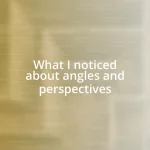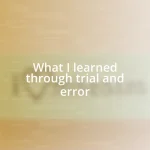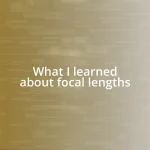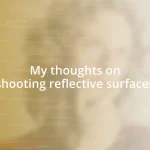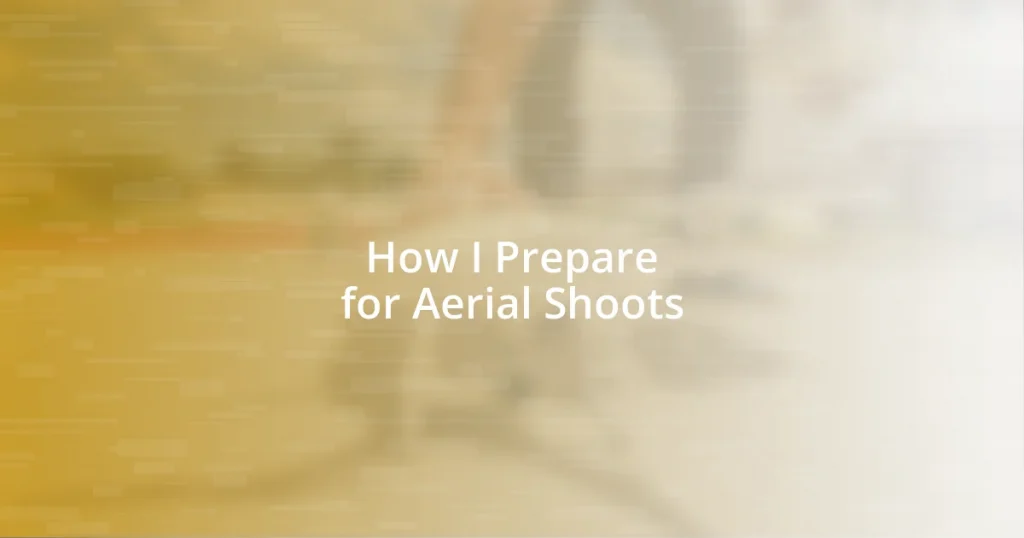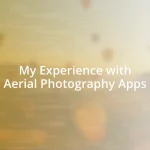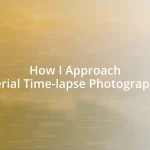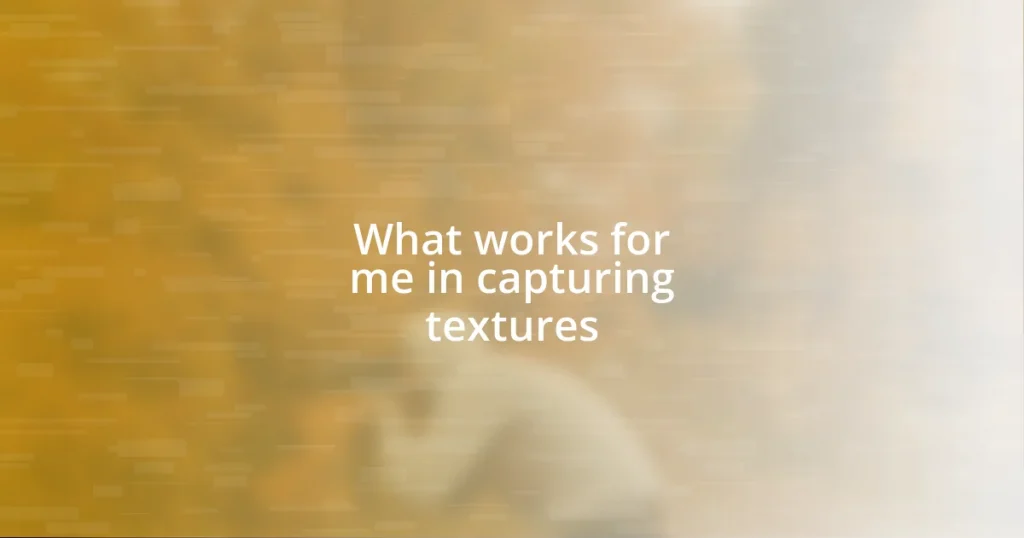Key takeaways:
- Thorough location scouting, obtaining necessary permissions, and understanding lighting are crucial for successful aerial shoots.
- Using high-quality equipment, such as reliable drones and stabilizing gimbals, is essential for capturing stunning and steady footage.
- Effective post-production techniques, including color correction and thoughtful cropping, enhance the storytelling and emotional impact of aerial photos.

Understanding Aerial Shoot Basics
When it comes to aerial shoots, understanding the basics is crucial. For instance, I vividly remember my first experience navigating the complexities of aerial filming. The rush of excitement was palpable, but it quickly turned to anxiety as I wrestled with my drone’s controls amid turbulent winds. Was I really prepared for this?
One fundamental aspect is the importance of location scouting. I often find that a seemingly mundane spot can transform into a cinematic masterpiece when viewed from the sky. Have you ever looked at a familiar landscape and thought, “Wow, it looks so different up here!” That’s the magic of aerial perspective.
Finally, the weather can be your greatest ally or most formidable adversary. I recall a day when the clouds rolled in unexpectedly, shifting our schedule completely. It made me ponder: how often do we overlook weather forecasts? A well-planned shoot can quickly turn into a mess if you ignore the atmospheric conditions.

Essential Equipment for Aerial Shoots
Having the right equipment for aerial shoots is essential to capturing stunning footage. When I first began, I scrimped on gear. That was a mistake. Quality equipment not only enhances your visuals but also boosts your confidence during shoots. Here’s a rundown of the essentials:
- Drone: A reliable drone is the cornerstone of any aerial shoot. Brands like DJI offer various models tailored for filmmakers.
- Camera: Your drone should carry a high-resolution camera. I suggest using one with good low-light performance for those golden hour shots.
- Gimbal: A 3-axis gimbal stabilizes your camera, reducing shaky footage. Trust me, a smooth shot can elevate your entire project.
- Extra Batteries: Always carry spare batteries. I’ve found myself in a bind after my drone lost power mid-flight more than once.
- ND Filters: Neutral density filters help control the amount of light hitting your camera’s sensor, allowing for better control over exposure.
On top of these essentials, I’ve learned that planning is key. I once showed up for a shoot only to realize I’d forgotten my backup memory cards—talk about a rookie mistake! It’s essential to have all your gear prepared and easily accessible to ensure a smooth operation. Building a checklist has been a game-changer for me. Having a solid inventory can save you from potential disasters and keep your focus on creativity.

Planning Your Aerial Shoot Location
When planning your aerial shoot location, I can’t stress enough the importance of thorough research. I’ve had days where I arrived at a stunning site only to find it crowded with people or filled with unexpected obstacles. Imagine the disappointment I felt as I watched the golden hour slip away while I scrambled for solutions. Scouting locations beforehand can prevent these frustrations and ensure that the environment is not only visually appealing but also convenient for your equipment setup.
Another key aspect to consider is obtaining the necessary permissions. In my early days of aerial shooting, I underestimated this step and faced fines that could have easily been avoided. I learned the hard way that a little advance communication with local authorities goes a long way. Securing the right permits not only keeps you legally covered but can also open doors for more significant opportunities, such as exclusive access to unique locations that others might not have.
Don’t overlook the power of light and time of day in your location planning. I remember a morning when I woke up at dawn, driven by my vision of capturing the sunrise over the mountains. The tranquility of that early hour transformed into pure magic as the sun peeked over the horizon, bathing everything in a warm glow. Choosing the right time can enhance the mood and tone of your footage dramatically, and I find it inspiring to think about how each location can evoke different feelings at various times of the day.
| Factors to Consider | My Experience |
|---|---|
| Location Research | Thoroughly scouting locations prevents disappointment and logistical headaches. |
| Permissions | Obtaining necessary permits avoids legal issues and can grant exclusive access. |
| Lighting | Capturing the right light at optimal times transforms the visual quality of your shoot. |

Safety Considerations for Aerial Photography
When it comes to aerial photography, safety should always be a top priority. I remember the adrenaline rush I felt during my first drone flight—excitement mixed with a hint of anxiety about potential crashes. Ensuring that I have a safety checklist before every shoot has become a ritual for me. It includes things like checking the weather, maintaining a safe distance from people and structures, and being mindful of airspace regulations. After all, no shot is worth risking someone’s safety.
I’ve also learned the hard way that good communication with my team is crucial. During one shoot, I was so focused on framing the perfect shot that I didn’t notice my assistant frantically waving at me from below. It turned out we were too close to a no-fly zone. Since then, I make it a point to establish clear signals and regular check-ins with my crew. Engaging openly with your team not only enhances safety but also helps everyone stay on the same page, which is vital for a smooth operation.
Lastly, I can’t stress how essential it is to understand your drone’s capabilities and limitations. I once underestimated the battery life on a particularly windy day, thinking I could push the limits for just one more shot. That decision led to a nail-biting sprint to retrieve my drone after it landed unexpectedly far away. Familiarizing yourself with your equipment ensures you know when to reel it in. Trust me, being proactive about your gear can make all the difference between an exhilarating experience and a stressful one.

Techniques for Capturing Aerial Shots
One technique I’ve found indispensable in capturing stunning aerial shots is utilizing different flight paths. I remember during one shoot, I decided to weave my drone in and out of trees, creating a dynamic, almost cinematic feel to the footage. This approach not only made the visuals more engaging but also allowed me to discover unexpected compositions that would have otherwise gone unnoticed. Have you ever thought about how a simple change in your flight direction can completely alter the shot’s impact?
Another valuable technique is incorporating foreground elements into your compositions. On one occasion, while shooting over a coastal area, I positioned the drone to frame rocky cliffs in the foreground against the vast ocean backdrop. This layering technique produced an image that felt alive, giving context and depth to the wide shot. I often emphasize how this method can transform an ordinary scene into something captivating by drawing the viewer’s eye across the image.
Lastly, using varying altitudes is a game-changer. There’s a thrill I feel when I experiment with different heights—it can drastically alter the perception of a shot. I recall a time when a low altitude allowed me to capture the intricate patterns of a field from above, while a higher vantage point provided a sweeping view that showcased the landscape’s grandeur. Isn’t it fascinating how something as simple as changing your altitude can lead to entirely different storytelling opportunities?

Post-Production Tips for Aerial Photos
When it comes to post-production, my first step is always to sort through the raw images before diving into editing. I often find myself setting aside time to review each shot with fresh eyes, which allows me to select the standout images that resonate with my intended story. It’s amazing how stepping back can help you notice details you might have missed in the excitement of the shoot—have you ever had that experience? I certainly have.
Color correction is another area where I invest a lot of my attention. I remember a shoot where the sunset hues were so vibrant that I felt they told their own story. However, in post-production, I realized that adjusting the saturation slightly elevated the mood even more. Striking that balance in post can transform an image from simply beautiful to emotionally compelling. It’s a delicate dance between enhancing reality and staying true to the moment.
Lastly, I often experiment with cropping and framing during the editing phase. One time, I captured a breathtaking aerial shot of a mountain range, but it wasn’t until I cropped the edges that the composition truly came to life. Suddenly, the focus shifted, and that image became a powerful statement. Have you considered how changing the frame can alter perception? Each decision in post-production can amplify what your original intention was, creating a final product that’s not just a photo, but an artistic expression.



